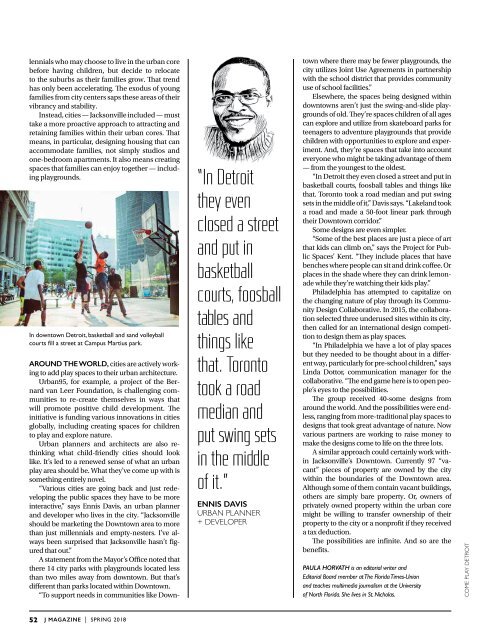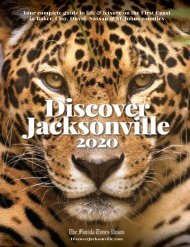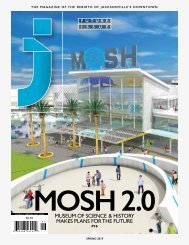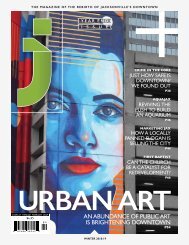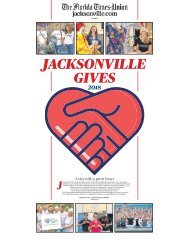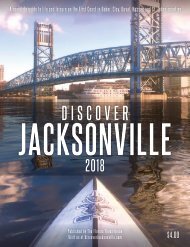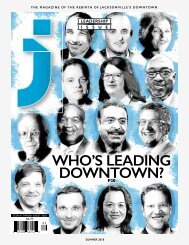J Magazine Spring 2018
Create successful ePaper yourself
Turn your PDF publications into a flip-book with our unique Google optimized e-Paper software.
lennials who may choose to live in the urban core<br />
before having children, but decide to relocate<br />
to the suburbs as their families grow. That trend<br />
has only been accelerating. The exodus of young<br />
families from city centers saps these areas of their<br />
vibrancy and stability.<br />
Instead, cities — Jacksonville included — must<br />
take a more proactive approach to attracting and<br />
retaining families within their urban cores. That<br />
means, in particular, designing housing that can<br />
accommodate families, not simply studios and<br />
one-bedroom apartments. It also means creating<br />
spaces that families can enjoy together — including<br />
playgrounds.<br />
In downtown Detroit, basketball and sand volleyball<br />
courts fill a street at Campus Martius park.<br />
“In Detroit<br />
they even<br />
closed a street<br />
and put in<br />
basketball<br />
courts, foosball<br />
tables and<br />
things like<br />
that. Toronto<br />
took a road<br />
median and<br />
put swing sets<br />
in the middle<br />
of it.”<br />
ENNIS DAVIS<br />
URBAN PLANNER<br />
+ DEVELOPER<br />
Around the world, cities are actively working<br />
to add play spaces to their urban architecture.<br />
Urban95, for example, a project of the Bernard<br />
van Leer Foundation, is challenging communities<br />
to re-create themselves in ways that<br />
will promote positive child development. The<br />
initiative is funding various innovations in cities<br />
globally, including creating spaces for children<br />
to play and explore nature.<br />
Urban planners and architects are also rethinking<br />
what child-friendly cities should look<br />
like. It’s led to a renewed sense of what an urban<br />
play area should be. What they’ve come up with is<br />
something entirely novel.<br />
“Various cities are going back and just redeveloping<br />
the public spaces they have to be more<br />
interactive,” says Ennis Davis, an urban planner<br />
and developer who lives in the city. “Jacksonville<br />
should be marketing the Downtown area to more<br />
than just millennials and empty-nesters. I’ve always<br />
been surprised that Jacksonville hasn’t figured<br />
that out.”<br />
A statement from the Mayor’s Office noted that<br />
there 14 city parks with playgrounds located less<br />
than two miles away from downtown. But that’s<br />
different than parks located within Downtown.<br />
“To support needs in communities like Downtown<br />
where there may be fewer playgrounds, the<br />
city utilizes Joint Use Agreements in partnership<br />
with the school district that provides community<br />
use of school facilities.”<br />
Elsewhere, the spaces being designed within<br />
downtowns aren’t just the swing-and-slide playgrounds<br />
of old. They’re spaces children of all ages<br />
can explore and utilize from skateboard parks for<br />
teenagers to adventure playgrounds that provide<br />
children with opportunities to explore and experiment.<br />
And, they’re spaces that take into account<br />
everyone who might be taking advantage of them<br />
— from the youngest to the oldest.<br />
“In Detroit they even closed a street and put in<br />
basketball courts, foosball tables and things like<br />
that. Toronto took a road median and put swing<br />
sets in the middle of it,” Davis says. “Lakeland took<br />
a road and made a 50-foot linear park through<br />
their Downtown corridor.”<br />
Some designs are even simpler.<br />
“Some of the best places are just a piece of art<br />
that kids can climb on,” says the Project for Public<br />
Spaces’ Kent. “They include places that have<br />
benches where people can sit and drink coffee. Or<br />
places in the shade where they can drink lemonade<br />
while they’re watching their kids play.”<br />
Philadelphia has attempted to capitalize on<br />
the changing nature of play through its Community<br />
Design Collaborative. In 2015, the collaboration<br />
selected three underused sites within its city,<br />
then called for an international design competition<br />
to design them as play spaces.<br />
“In Philadelphia we have a lot of play spaces<br />
but they needed to be thought about in a different<br />
way, particularly for pre-school children,” says<br />
Linda Dottor, communication manager for the<br />
collaborative. “The end game here is to open people’s<br />
eyes to the possibilities.<br />
The group received 40-some designs from<br />
around the world. And the possibilities were endless,<br />
ranging from more-traditional play spaces to<br />
designs that took great advantage of nature. Now<br />
various partners are working to raise money to<br />
make the designs come to life on the three lots.<br />
A similar approach could certainly work within<br />
Jacksonville’s Downtown. Currently 97 “vacant”<br />
pieces of property are owned by the city<br />
within the boundaries of the Downtown area.<br />
Although some of them contain vacant buildings,<br />
others are simply bare property. Or, owners of<br />
privately owned property within the urban core<br />
might be willing to transfer ownership of their<br />
property to the city or a nonprofit if they received<br />
a tax deduction.<br />
The possibilities are infinite. And so are the<br />
benefits.<br />
Paula Horvath is an editorial writer and<br />
Editorial Board member at The Florida Times-Union<br />
and teaches multimedia journalism at the University<br />
of North Florida. She lives in St. Nicholas.<br />
COME PLAY DETROIT<br />
52<br />
J MAGAZINE | SPRING <strong>2018</strong>


